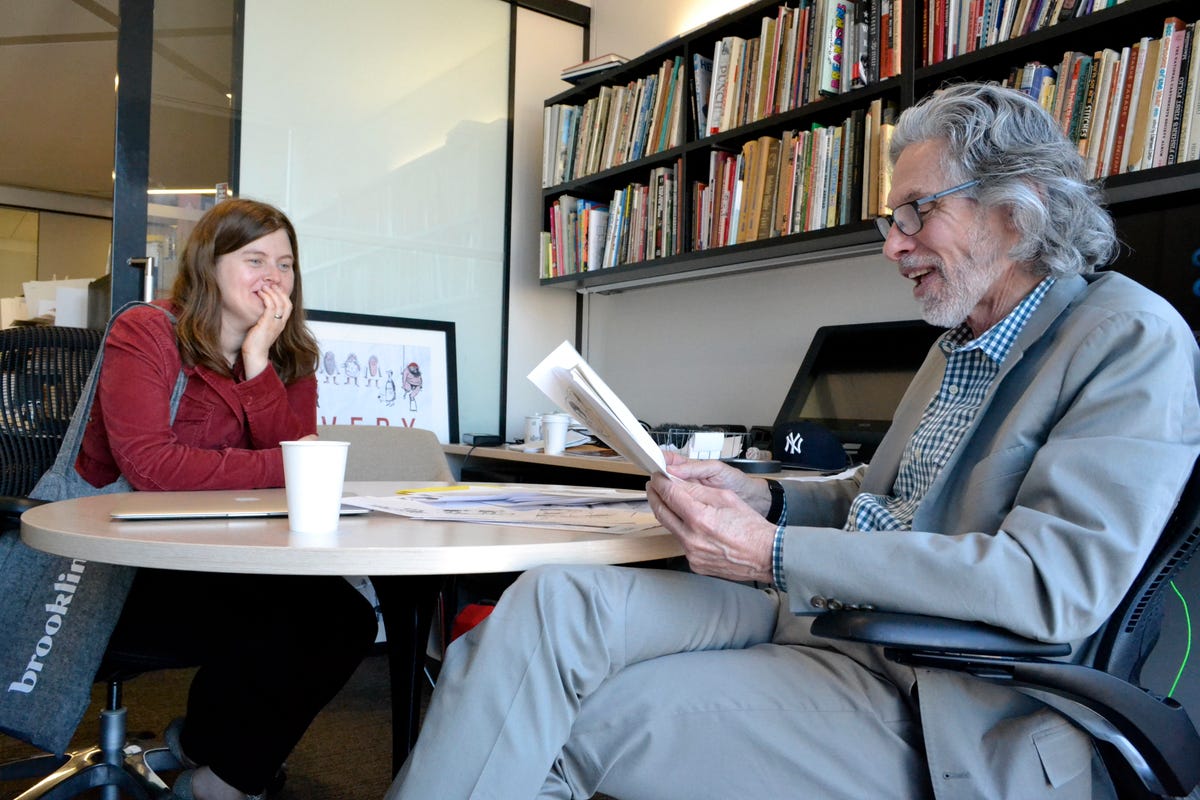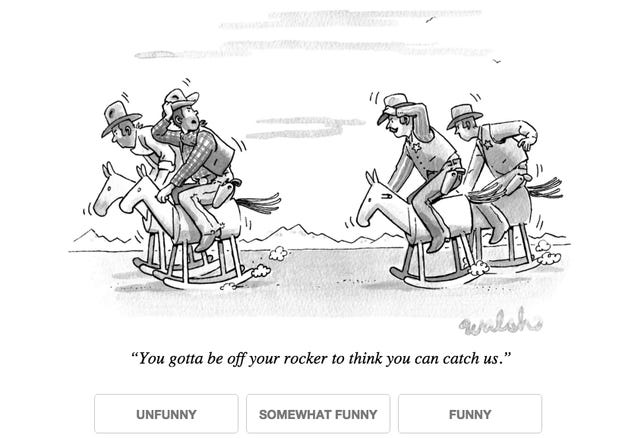On a bright Wednesday morning on the glass-encased 38th floor of One World Trade Center, about a dozen cartoonists waited anxiously outside Bob Mankoff’s office for a chance to pitch The New Yorker’s cartoon editor. Amid the pressure, at least one person was breathing easy: Colin Stokes, Mankoff’s assistant.
Not too long ago, Stokes would spend eight hours a week trawling through about 5,000 submissions for the magazine’s caption contest, which asks readers to pen a clever one-liner for a cartoon. The 18-year-old contest is wildly popular and winning it is prestigious enough to put on a resume. (OK, not really.) But Stokes was in danger of going, as Mankoff put it, “humor blind.” That’s something like snow blindness, but much rarer.
Luckily, a computer program has swooped in to save Stokes and his sense of humor. With the help of computer scientists from the University of Wisconsin at Madison, The New Yorker for the first time is using crowdsourcing algorithms to uncover the best captions. The magazine quietly started using the algorithms a few months ago, testing them out on past caption contest winners and finalists. On Wednesday, The New Yorker revealed the tool publicly and is now inviting all of us to vote for our favorite captions.
Mankoff plans to make the caption contest global (eligibility is now only in a handful of countries) and expects that the algorithms will help him do so without being crushed by a mountain of zingers.


New Yorker cartoon editor Bob Mankoff meets with cartoonist Emily Flake during his weekly open office hours.
Ben Fox Rubin/CNET
“The caption contest is intended for engagement,” said Mankoff, who spent 20 years as a cartoonist for the magazine before becoming cartoon editor nearly two decades ago. “There’s no reason why engagement shouldn’t continue with which ones you think are best.”
Mankoff, who has black metal glasses and wavy, gray hair past his ears, then predicted the voting tool will become so popular and profitable that it will eventually “be buried and ruined by advertising and cat videos.”
The usefulness of these new algorithms doesn’t help just one assistant. (My apologies, Colin.) Professor Rob Nowak, who led the University of Wisconsin team, said the crowdsourcing algorithms, after being honed by fresh caption contest data every week, could be used to answer big questions in science, engineering and medicine.
Because the algorithms can rapidly tease out the best choice from many options, they could help create better drugs to fight viruses or design more-secure communication networks. Ultimately, the data collected might even be able to teach a computer to understand what’s funny — and, perhaps, one day leave human comedians sweating as they work to up their routines.
The bottom line: The caption contest is…no laughing matter. (Sorry, I couldn’t help myself.)
“We really are trying to create algorithms that are trying to attack more-serious applications,” said Kevin Jamieson, a researcher at University of California at Berkeley who worked on the crowdsourcing algorithms. “These examples are kind of like practice for the real-world problems we want to solve tomorrow.”


Now playing:
Watch this:
Bob Mankoff shows off The New Yorker’s new crowdsourcing…
2:17
What’s so funny?
During my visit to The New Yorker, Mankoff walked me through the new voting tool in his office, which is decorated with a large framed image of the magazine’s 1997 cartoon issue cover and stocked with cartooning and comedy books. There are two worn volumes of “The World Encyclopedia of Cartoons.”


Here is a screenshot of the crowdsourcing tool. Click on the picture to try it out.
The New Yorker
On Mankoff’s computer screen, a web page presented us with one of the latest caption contest cartoons — three men in suits holding one giant briefcase — paired with one submitted caption at a time. Underneath were three buttons: “unfunny,” “somewhat funny” and “funny.” Mankoff quickly clicked through a bunch of captions (he’s been cartoon editor since 1997, so for him this was a breeze) while offering his opinion on the humor of each one.
“‘He’s not heavy, he’s my broker’,” Mankoff said, reading one submission aloud.
“That’s weird,” he added with a laugh before clicking the “unfunny” button. Why the fail? “It doesn’t quite explain why — it’s not providing an answer to the comic puzzle.”
As Mankoff clicked through one caption after another, algorithms behind the scenes were feverishly trying to bubble up the very best captions, using the responses from Mankoff and many others. The computer models Nowak and his team are developing are called adaptive crowdsourcing algorithms. They attempt to weed out the weakest captions as quickly as possible to get more people to vote on the potential winners.
“We want to drive the crowd to the top funniest captions,” Nowak explained, “instead of wasting their time with the ones that aren’t that funny.”
Nowak wants to develop an adaptive algorithm that could direct scientists to perform lab tests that are most likely to net the needed results, just like directing New Yorker readers to the potentially funniest captions. Using that kind of software could save money by shaving hours off countless research projects. He talks about trying to uncover the right genes for virus replication, as an example.
“It’s kind of like the contest,” Nowak said. “You really want to find the winners or the really important things, rather than just the good things.”


Picking out the latest cartoons for The New Yorker is serious business. From left are managing editor Silvia Killingsworth, editor David Remnick and Mankoff.
Ben Fox Rubin/CNET
Yucks, gags and algorithms

 Enlarge Image
Enlarge ImageI clicked “somewhat funny.”
The New Yorker
This isn’t the first time Mankoff has teamed up with computer scientists to study the caption contest, a once annual affair that’s been happening weekly since 2005. Last year, he worked with Microsoft researchers to create a computer program that tries to figure out which caption submissions are funniest. It predicted which of two captions was funnier 64 percent of the time. That’s pretty good for a robot, though not good enough for Mankoff to use.
But all this research could help nudge forward the slow work of teaching a computer what’s funny, something that scientists think could improve human-computer interactions and make digital voice assistants like Apple’s Siri sound less stiff. Mankoff, who dropped out of an experimental psychology Ph.D. program before falling into cartooning, has a keen interest in such issues.
“It fuels his imagination,” David Remnick, editor of The New Yorker, said of Mankoff’s academic dissections. “I don’t think it makes him any funnier, it makes him more intelligent. He was plenty funny before.”
How funny? One of Mankoff’s drawings is among the best-known New Yorker cartoons ever and became the inspiration for the name of his book about his life in cartoons. The caption: “No, Thursday’s out. How about never — is never good for you?”
Returning to algorithms, Mankoff laughs off the idea that he may be helping create a robot that could one day be as funny as him.
“In the end we’re human beings responding to other human beings. That’s the essence of humor,” he said. “Unless those computers are living, feeling, existing in the real world…I don’t think it’s going to be successful.”




